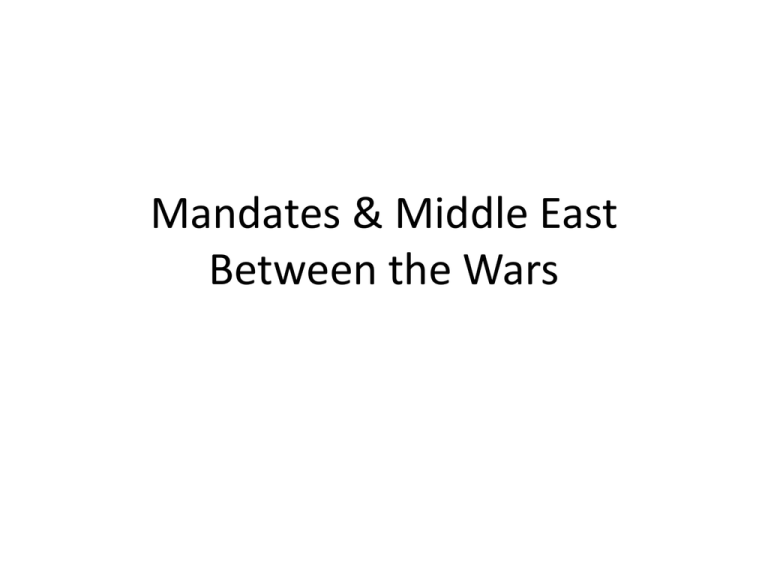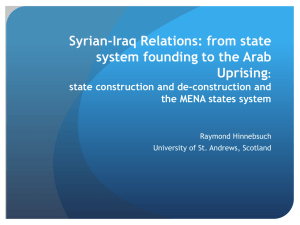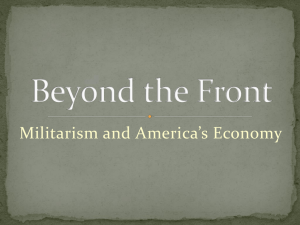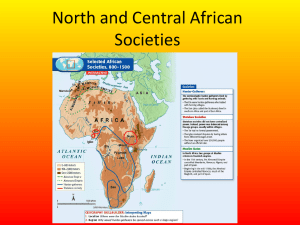Middle East Between the Wars
advertisement

Mandates & Middle East Between the Wars Mandate System • Paris Peace Conference determined that Sykes-Picot would be the determining definition of the post war mandates carried out by the League of Nations – Mandate was intended to transfer power from the former state (Ottoman) to one of the victorious allies – France would oversee Lebanon and Syria on behalf of League of Nations – Britain, Palestine and Mesopotamia (Iraq) • In testimony before the Senate Committee on Foreign Relations a former US State Department official who had been a member of the American Commission at Paris, testified that the Britain and France had simply gone ahead and arranged the world to suit themselves. • League of Nations could do nothing to alter their arrangements, since the League could only act by unanimous consent of its members - including the UK and France. Problems with the Mandate • Britain and France encountered two difficulties with the Sykes-Picot boundaries: 1. previous concessions for oil rich Mosul region were not considered and this raised conflicts 2. League of Nations resolved that Britain should honor the Balfour Declaration but no provision for the Zionists was made with Sykes-Picot • Following World War I, King Faysal moved into Damascus and set up an Arab state in Syria on October 1, 1918. “Discovery” of Middle East Oil • Following 1892 when archeology professor Jacques de Morgan discovered oil in ancient Susa of Western Iran, a flurry of oil prospectors came looking for oil in Middle East • Since ancient times, oil was known in the region of eastern Iraq to bubble up from the ground. • before and during World War I, the potential of petroleum products for fuels was realized to be superior to that of coal. The major powers sought global sources of new resource. • British established exclusive oil rights (concession) in western Iran 1908 with Anglo-Persian Oil Co. Mosul Oil • Other countries scrambled to Sultan Abdul Hamid II in 1904-1912 to establish concessions for oil known to be present in commercial proportions around Mosul • In order to shut out the competition, the British, Dutch and Germans formed the Turkish Petroleum Company in 1912 (British held 50%, Dutch and Germans 25% each) – American prospectors under the Chester Group were excluded along with the French. • Chester group still got a foot in door by securing a concession to construct railroads in Ottoman Mosul • Sykes-Picot did not take oil into consideration San Remo Agreement • British faced the awkward position of having controlling oil rights in a region belonging to French • this, coupled with their desire to convince the French to agree to accommodate the Zionists, forced the British to settle these issues with another conference in San Remo April 24, 1920 • in exchange for acquisition of the 25% share formerly held by the Germans, French agreed to change the mandate boundaries so that British controlled the Mosul region • In addition, Britain was to oversee the mandate of Palestine with the text of Balfour Declaration included and a number of points which Zionists presented: – establishment of Jewish Agency by Zionists to administer the Jewish state within the British mandate • Again, plans to establish and Arab state were simply not mentioned New Nations Are Formed • The mandates carved out of the Ottoman Empire new national boundaries and states that largely remain unchanged to this day: – Syria (under French) – Lebanon (under French) – Iraq (under Britain) – Transjordan (later Jordan) (under the British) – Palestine (later become Israel except Gaza) – Kuwait (under British) separate from Iraq Faysal and French • Arab leaders had pinned their hopes on King-Crane Commission which recommended that 1. Britain be given mandate to south (Iraq) 2. US mandate of Syria (undivided and including Lebanon and Palestine) 3. Faysal be made constitutional monarch of Syria 4. Zionists be allowed to become Syrian citizens, not independent state – furthermore, the Commission correctly predicted war if Syria were given to the French • These hopes were dashed when Brit/Fr chose to ignore the US report and French troops replaced British occupying forces in Lebanon & Syria in 1919. Syria’s Short-Lived Independence • The Syrian Congress let by Fatat Society, announced independence on March 20, 1920 and appointed Faysal as ruling monarch • British & French were preoccupied w/ San Remo meanwhile, French and Syrian forces prepared for war. France’s high commissioner in Syria, General Gouraud issued an ultimatum to the Syrians: – immediate acceptance of French mandate – reduction of Syrian army and abolition of conscription – punishment of all those in rebellion • Syrians were in no position to fight superior French forces, but in gallant act of defiance, Syrian Congress voted unanimously to reject the ultimatum Battle of Maysalun • French forces, consisting of Africans, Algerians, Moroccans and Senegalese converged on Damascus. • A battle occurred at Maysalun on July 24, 1920 lasted half a day and Syrians were defeated. • victorious French forces entered Damascus forcing Faysal to flee after only 22 months of reign French Mandate of Syria-Lebanon • As predicted, French rule in Syria was sure recipe for war, igniting bitter resentment in Syrians • French were harsh, condescending and paternalistic, wishing to “bestow the blessings of French culture on non-western world” • To make matters worse, contrary to Syrian wishes to keep the Levant intact, Gouraud adopted a “divide and conquer” policy, separating Lebanon, Latakia, Aleppo, Damascus and Jabal Druze into districts – Druze were 11th century sect of Islam that were crucial in helping Mamluks drive off Crusaders French Mandate • Henry Gouraud established a pattern of favoritism toward Catholic Maronites in Lebanon and sought to propagate Catholicism through Syria – subsequent high commissioners would continue this policy – discouraged influence of Islamic ulama • Syrians were never able to adjust to the separation imposed by the French • Syria would be subject to wars and violence constantly for next 26 years French Mandate • First Revolt occurred in 1925 after the high commissioner invited Druze leaders to a banquet and then arrested them – Druze chieftain Sultan al-Atrash who had not attended the banquet attacked the French garrison in Jabal Druze – this was a signal for Syrian uprisings in Damascus, Homs, Hama and other cities. – the French moved in with armor and planes but the insurgency dragged on until 1927 • Finally the military high commissioner was replaced by a civilian who entered into negotiations with Syrian leaders – the Nationalist Block party (al-Kutla al-Wataniyya) demanded autonomy of a united Syria of all districts except Lebanon – over the next eight years the Syrian nationalists and the French haggled over the form of government, constitution and degree of independence the future Syria would have Sultan al-Atrash • Good friend of Faysal, fought with him during the Arab Revolt and helped him take Damascus in 1918 • Al-Atrash won several battles against the French at the beginning of revolution in 1925, • Al-Atrash is known for his secularism when he raised the slogan "Religion is for God, the fatherland is for all" • France sent thousands of troops to Syria and Lebanon from Morocco and Senegal, equipped with modern weapons, compared to the few supplies of the rebels. This dramatically altered the results and allowed the French to regain many cities, although resistance lasted until the spring of 1927 • The French sentenced Sultan al-Atrash to death, but he had escaped with the rebels to Transjordan and was eventually pardoned. • He returned to Syria in 1937 after the signing of the Franco-Syrian Treaty. He was met with a huge public reception. Druze warriors 1925 Atrash leading Druze forces during Syrian revolt French Mandate • Under pressure by the rise of Hitler and the incursion of Mussolini into Ethiopia, the French felt compelled to accommodate the Syrians • In September 9, 1936, a treaty was signed granting the Syrians some form of independence – the nationalists won the elections – chose Hashim al-Atassi as President – Jamil Mardam as first Prime Minister • Unfortunately, World War II ended the short-lived Syrian independence French Mandate • The situation in Lebanon was different and relatively peaceful for a number of reasons: – population was much more diverse included a substantial number of Catholics and other Christians – politics were not as volatile – while Syria revolted in 1925, Lebanon was granted partial independence (but not sovereignty) in 1926 – Lebanese established a republic and elected Charles Dabbas as the first president. • After a short time, the French revoked the constitution and struck the independence • Finally, in 1936, the French restored the constitution of 1926 although they retained a lot of secret controls over their mandate. World War II would end all of that. British Mandate Absorbs Faysal • British were quite different from their French counterparts. – British officers served side by side with Arab officers in the Arab Revolt of WWI and were much more empathetic – political parties in Iraq in 1920’s did not have as extreme nationalistic feelings as the Syrians • the first dilemma occurred when French ousted Faysal from Syria. – British felt a sense of obligation to Hashimite family and while Faysal was monarch in Syria, his brother Abdullah was appointed Emirate of Transjordan under British mandate – in 1920 when Faysal, was expelled by the French, the British had “two kings” on their hands – sensing Faysal was the more popular of the two brothers, the British appointed Faysal the Emirate of Iraq Faysal and Abdullah British Mandate • Despite Britain's desire to be more accommodating to the Arabs due to a sense of obligation in wake of failed Husayn-McMahon, the mandate in Iraq had rough beginnings: – administration of mandate was handled by the government of India (“Anglo-Indians”) who behaved as if they might annex Iraq – British high commissioner surveyed Iraqis and was surprised to learn that they “preferred” British to Indians – nationalist movements in Turkey (Kemalists), Egypt and Syria began to sway nationalistic feelings in Iraq – results of San Remo was unpopular among Arabs Iraqi Revolt • announcement of San Remo and attitude of Anglo-Indians precipitated revolt in July 1920, led by embittered former officers under Ottomans • British countered by sending 65,000 troops and after considerable fighting, London took control and Sir Percy Cox became the new High Commissioner • Cox collaborated with former Ottoman officials and tribal, sectarian, and religious leaders and oversaw the creation of a largely Arab provisional government. Council members were culled from local elites whom Cox felt could be relied upon to support the British agenda. • The satisfactory functioning of this interim government allowed Cox to attend the Cairo Conference, convened by the new Colonial Secretary Winston Churchill in 1921 Revolt in Iraq • The start of the revolution in May 1920 was centered on peaceful protests against British rule. – There were large gatherings at Sunni and Shi’a mosques which gave proof of co-operation between the two main sects of Iraqi society. – At one of the larger meetings fifteen representatives were nominated to present the case for Iraqi independence to the British officials. – Acting Civil Commissioner, Sir Arnold Wilson, dismissed their demands as unpractical. • • • Armed revolt broke out in late June 1920. Ayatollah al-Shirazi issued another fatwa that seemed to encourage armed revolt. The British authorities hoped to avoid this and they arrested a sheikh of the Zawalim tribe. but an armed band of loyal tribal warriors stormed the prison and set him free. The revolt soon gained momentum as the British garrisons in the mid-Euphrates region were weak and the armed tribes much stronger. – By late July, the armed tribal rebels controlled most of the mid-Euphrates region. – The success of the tribes caused the revolt to spread to the lower Euphrates and all around Baghdad too. – British War Minister, Winston Churchill, authorized immediate reinforcements from Iran that included two squadrons of the Royal Air Force. The use of aircraft shifted the advantage to the British and played a huge role in ending the revolt. – There were also tribes that worked against the revolt since they were recognized by the British authorities and profited from this acknowledgement. Eventually the rebels began to run low on supplies and funding and could not support the revolt for much longer while British forces were becoming more effective. The revolt ended in October 1920 when the rebels surrendered Najaf and Karbala to the British – Around 6,000 Iraqis and around 500 British and Indian soldiers died in the revolt. The revolt caused British officials to drastically reconsider their strategy in Iraq. Cairo Conference 1921 • The new Colonial Secretary, Winston Churchill, decided a new colonial administration was need in Iraq as well as the British colonies in the Middle East so he called for a large conference in Cairo. • In March 1921 at the Cairo Conference, British officials discussed the future of Iraq. – The British now wanted to control Iraq through more indirect means, mainly by installing former officials friendly to the British government. • They eventually decided to install Faysal ibn Husayn as King of Iraq. – Faysal had worked with the British before in the Arab Revolt during World War I and he enjoyed good relations with certain important officials. – British officials also thought installing Faysal as king would prevent Faysal from fighting the French in Syria and damaging British-French relations. • For Iraqis the revolt served as part of the founding of Iraqi nationalism although this conclusion is debated by scholars. – It also showed unprecedented co-operation between Sunni and Shi’a Muslims – this co-operation did not last much longer than the end of the revolt.[ Cairo Conference 1920 • Cox saw to it that leaders in Iraq extended an invitation to Faysal to be their king. • Abdullah in meantime was made Emirate of Transjordan • Cox also began the process of working with Faysal and Iraqi leaders to form an independent Arab state • Faysal was astute politician and managed to walk a treacherous line between Syrian nationalist extremists on one hand and complete subservience to the British on the other. Iraq Becomes the First Independent Arab State • After an eight year struggle in which Arab nationalists demanded more than what British imperialists were willing to give, a treaty was signed in 1930. • In exchange for independence, Iraq agreed to give Britain base rights at Basra (naval) and Habbaniya (airfield) and in time of war, Iraq agreed to put its resources in the hands of the British • in 1932, both Britain and Iraq ratified the treaty and the British mandate officially came to an end. • Unfortunately, this happy outcome would only be short-lived, because Faysal’s stabilizing influence in Iraq would end with his death in 1933. Divisions in Iraq • There were differences in opinion as to whether Iraq was really independent or not: – those in favor of the alliance with Britain included the National Party, the Progressive Party, the old Ahd Party of pre-mandate days under Gen. Nuri al-Sa’id – those opposed were National Brotherhood, Ikha al-Watani Party led by Yasin al-Hashimi & Rashid al-Gailani • Even though the vast majority of Iraq’s 5 million people were Muslims, they belonged to three hostile camps: Sunni, Shi’i and Kurdish – the Sunni minority ruled the Shi’i majority – there were Kurds and Assyrian Christians in the mountains Faysal Struggles to Keep Things Together • despite these challenges, Faysal wanted to transform the varied religious and ethnic groups into a nation. – he tried to reconcile Sunnis and Shi’is – open new schools, promote industry, solve land issues – he worked to bring about a coalition government with Yasin al-Hashimi as prime minister • National Brotherhood Party dominated parliament from 1932-1936 • When Faysal died in 1933, his son Ghazi was not strong enough to keep the Brotherhood and the dictatorial Hashimi in check General Sidqi Stages First Coup • In 1936, during the reign of Faisal's ineffectual son King Ghazi I, • Sidqi, then acting commander of the Iraqi Army, staged what was probably the first modern military coup d'état in the Arab world against the government of Yasin al-Hashimi. – he assassinated popular defense minister Jafar al-Askari who dared to oppose him, a move which embittered many in the army against him • Eleven Iraqi military planes dropped leaflets over Baghdad on October 29, 1936 requesting the King for the dismissal of al-Hashimi’s administration and for the installment of the ousted anti-reform Prime Minister Hikmat Sulayman. Iraqi Political Controversies • This began jockeying for power that would plague Iraqi politics – Sadqi would last one year and then be assassinated in another coup d’etat, then there would be a third as army leaders turned against one another – General Nuri al-Sa’id held on to the reins when WWII started – King Ghazi was killed in a car crash in 1939 (many allege was no accident) • Kuwait was the oil-rich British protectorate which Iraq claimed but was denied sovereignty • There was the controversy of Iraqi nationalism vs larger pan-Arab nationalism Mandate of Transjordan • mostly desert expanse with some 200,000 inhabitants, mostly Bedouins, Transjordan continues to this day under the descendents of the Hashemite Emir Abdullah al-Husayn • This Emirate remained loyal to Britain until after World War II – in return the British organized one of the best trained and equipped armies in the Fertile Crescent – Arab Legion under Glubb Pasha (Sir John Glubb) Glubb Pasha • Glubb served his home country all through his years in the Middle East, making him immensely unpopular in the end. • Arab nationalists believed that he had been the force behind pressure that made King Hussein I of Jordan join the Baghdad Pact. Glubb served different high positions in the Arab Legion, the army of Transjordan. • During World War II he led attacks on Arab leaders in Iraq, as well as the Vichy regime which was present in Lebanon and Syria. • During the 1948 Arab–Israeli War the Arab legion was considered the strongest Arab army involved in the war. Glubb led the Arab Legion across Jordan to occupy the West Bank. Transjordan • the government was simple: – the administrative and legislative powers were vested in the Emir, who like a paternal benefactor, ruled the country with an executive council to assist him – Membership in legislative council proportional representation depending on the size of the Bedouin or other ethnic groups in a certain area • British citizens in Transjordan supervised the administration and controlled the budget, the army, and foreign affairs Abdullah’s Ambition • After his brother Faysal’s death in 1933, Abdullah assumed role as head of Hashemites • He desired for unity among Arabs of Fertile Crescent and supported “The Greater Syria Movement” – he envisioned a united Fertile Crescent under rule of Hashemites as specified in Husayn-McMahon – Saudi Arabia and Egypt opposed the plan as did all the nationalistic political parties of Syria and Iraq Saudi Arabia Saudi Arabia • The Saud clan in Arabia owed much of its influence to being allied with a movement started by Muhammad Ibn ‘Abd al-Wahhib, the founder of Wahhibism. • Wahhib found an ally and protector in the head of the Saud clan, Muhammad Ibn Saud Ibn Muqrin. – When Wahhib died, the Saudi leaders carried the torch as both the spiritual and political heads of Wahhibism. – Their objective was to stem the tide of foreign domination and influence and to restore the traditional rule of Islam. • The Saud family, like other clans on the Arabian Peninsula, had been torn by internal strife for more than a century with endless treachery and feuding. This constant tension and conflict represents a general pattern. Conquest of Arabia • Ibn Saud faced some challenges, with rival clans such as the Rashid clan who controlled Riyadh; and outsiders such as the Turks who controlled the western region known as Hasa and the Hashemites who controlled the Hijaz along the Red Sea. • In 1902, ibn Saud, seized Riyadh in Nejd from the Al Rashid – the first of a series of conquests ultimately leading to the creation of the modern state of Saudi Arabia in 1932. • The main weapon for achieving these conquests was the Ikhwan, the Wahhabist-Bedouin tribal army led by Sultan ibn Bijad and Faisal Al-Dawish • Following collapse of the Ottoman Empire after World War I, the Ikhwan had completed the conquest of the territory that was to become Saudi Arabia by the end of 1925 – On 10 January 1926 ibn Saud declared himself King of the – on 27 January 1927 he took the title of King of • In 1932, the two kingdoms of the Hejaz and Nejd were united as the Kingdom of Saudi Arabia. Conquest of Arabia • Though the British had supported Hussein from the start of the Arab Revolt and the Husayn-McMahon Correspondence, they elected not to help Hussein repel the Saudi attack, which eventually took Mecca, Medina, and Jeddah. • Husayn was then forced to flee to Cyprus where he was received with great honor by the British and received the Order of St. Michael Spurred on by Ikhwan • By 1934, he consolidated Najd, Hasa, Hijaz and ‘Asir into the Kingdom of Saudi Arabia. – In so doing, he healed rifts within his own family, forced rival clans into submission, taken Hasa from the Turks and conquered Mecca and Hijaz. • One of the major reasons for his success was than Ibn Saud formed the Ikhwan (Brotherhood) movement in which he recruited warlike Bedouins into service for Allah and used them to settle the land they conquered. – The religious ideology of Ikhwan was a puritan zeal that helped bind the society fragmented by rivalries together. – The Ikhwan served as the rallying cause that drove Ibn Saud’s forces from one military victory after another. – Ibn Saud had a strong belief that he was fighting for a spiritual cause and that he was being directed by the will of Allah. Downfall of Ikhwan • After the conquest of the Hejaz, the Ikhwan leaders wanted to continue the expansion of the Wahhabist realm into the British protectorates of Transjordan, Iraq and Kuwait • In August 1924, the Ikhwan militia traveled 1,600 kilometers (990 mi) from Najd to attack Transjordan under British protectorate. – Just 15 kilometers off Amman, the raiders were spotted by the British RAF, which in turn attacked the Ikhwan using airplanes. The Ikhwan army suffered heavy casualties. It is reported that out of the 1500 raiders, only 100 escaped – ibn Saud, however, refused to agree to thes raids, recognizing the danger of a direct conflict with the British. The Ikhwan , accused ibn Saud of failing to adhere to Wahhabism and revolted but were defeated in the Battle of Sabilla in 1930 – the Ikhwan leadership were massacred. – They were reorganized into Saudi Arabian National Guard which is the King’s personal guard Coming to terms • Ibn Sa’ud had led the Wahhabis in becoming the new masters of Arabia raised concerns among the rest of Islam and neighboring states: 1. Wahabbis were puritan fanatics that considered other Muslims to be “polytheists” and now controlled access to the Ka’ba 2. ibn Sa’ud was the arch rival of the Hashemite family, which the British placed in charge of neighboring Transjordan and Iraq • ibn Sa’ud called an Islamic conference in Mecca June 7, 1926 in order to provide other ulama opportunity to meet with his Wahhabi ulama – other Muslim delegates were impressed with the wisdom of the tall monarch Saudi Government • After 1934, Ibn Saud spent the next almost twenty years developing an elaborate patrimonial government. • The discovery of oil at Jebel Dhahran in 1938 propelled the government to be one of the richest in the world. – When Ibn Saud died in 1953, his annual income was close to $275 million. • Even today, Saudi Arabia represents one of the world’s greatest patriarchies. – It is operated as a giant personal household. – In a system of patrimonial rule, the leader relies very strongly on constant faceto-face contact as a means to control personalities. – At the heart of the government is the family of the ruler. – Ibn Saud had an estimated 300 wives and the countless princes are the his ministers. – It is estimated there is one prince for every 5,000 people in Saudi Arabia. – There is purpose in marrying many wives. Ibn Saud often married the widows and adopted the orphan children of important allies and rivals killed in battle in order to seal lasting friendly relationships with their families. Through the years, he married into all the leading families in Arabia including the Wahhabis, the Rashids, and many others. Patrimonial Leadership Model • The Patrimonial leader represents a father figure who always encourages his children to come to him with their troubles. • Ibn Saud was famous for his devotion to hearing the compliments and complaints of all his subjects who came to him regardless of their social status or position in life. – When the visitor departed, they always received a gift from the patriarch and left as well with a deeper loyalty to their benevolent king. • Under his guidance, Saudi Arabia achieved order and tranquility rather than internal strife and foreign domination. • On the downside, with a patrimonial system, sudden and great wealth seldom lead to reform and modernization. – These resources become clogged in the pockets of the patrimonial family. – The result is Rolls Royces and 25-million dollar palaces alongside abject poverty and illiteracy. Saudi Oil • From WWI it was learned that oil would be necessary to win future wars • First, the Anglo-Persian Oil Company was established, prospectors claimed there was no oil in Saudi Arabia except in eastern seaboard of alHasa • After the depression hit, the number of pilgrimages per year fell from 100,000 to below 40,000. This hurt their economy greatly and they needed to find alternate sources of income. This caused the King to get serious about the search for oil











